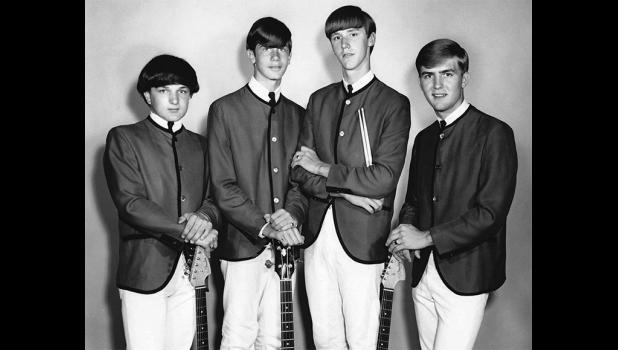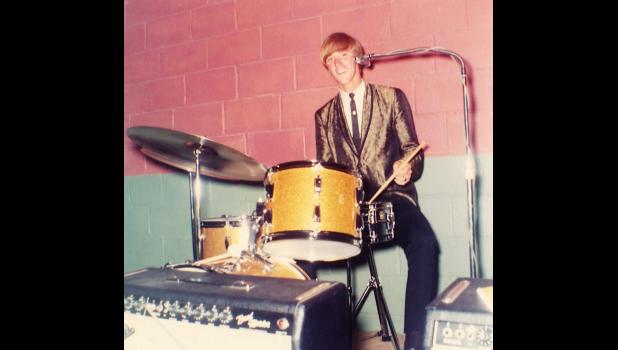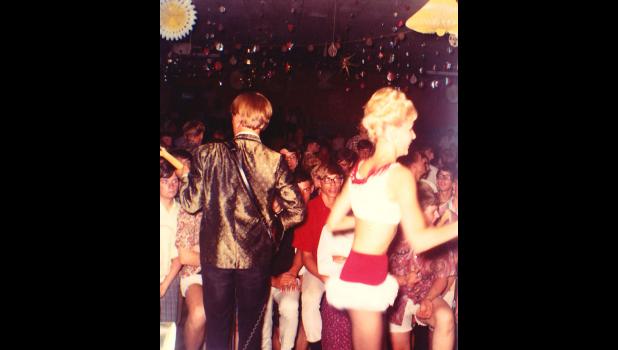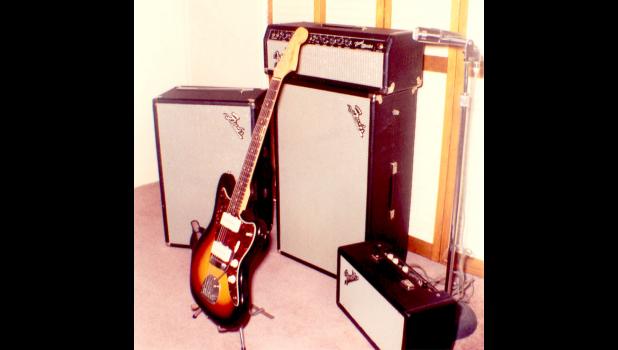Hall of Fame bound
By ANDREW MCGINN
a.mcginn@beeherald.com
More than 53 years ago, David Williamson mailed a mimeographed letter to the owner of Fort Dodge’s Plamor Ballroom to introduce a new rock ‘n’ roll band in Jefferson called the Bushmen.
Included in the letter was an introductory offer to book the group for the low, low price of $50.
“I never heard anything from anybody,” Williamson, the band’s lead guitarist and lead singer, recalled this week.
A year later, with word spreading that the four Bushmen had the chops to rightfully wear their collarless Beatle jackets, the owner of the Plamor phoned Williamson and asked him to name his price.
“I remember saying, ‘$120,’ ” Williamson explained, hoping the owner wouldn’t remember that earlier offer to play for $50. “He said, ‘OK, no problem.’ ”
After the show, Williamson finally leveled with the owner.
“We’re the same band you could have had a year ago for 50 bucks,” Williamson remembers saying. “He said, ‘Man, I don’t hire $50 bands. If you’re only worth $50, I don’t want you.’ ”
With that said, their price just went up.
The Bushmen will be inducted Labor Day weekend into the Iowa Rock ‘n’ Roll Hall of Fame, it was announced Monday.
The quartet of Williamson, rhythm guitarist Roger Dunlop, bassist-vocalist Bruce (Smith) Banister and drummer-vocalist David Baller — who last played together in July 1966 at the Greene County Roller Rink — will be the first band from Jefferson to be enshrined in the hall of fame, located at Arnolds Park on Lake Okoboji.
“We all are honored,” said Dunlop, who now resides at Lake Panorama. “It’s nice to be remembered.”
With the induction comes an expectation that the Bushmen will perform live that weekend at Arnolds Park as part of the festivities.
“When we quit in ’66, I never thought I’d be performing 52 years later for the Iowa Rock ‘n’ Roll Hall of Fame as an inductee,” said Baller, a 1967 graduate of Jefferson Community High School.
The 2018 hall of fame class also includes the Nadas, the popular Des Moines band, and David Ellefson, famed bassist for metal titans Megadeth, who grew up near Spirit Lake, just across the border in Jackson, Minn.
Williamson said that band members are in the process of prepping a 30-minute set — their first in 52 years — of period goodies by the Stones, Kinks, Young Rascals and others.
“It’s certainly good news for the fans of our band,” said Williamson, who will turn 70 that same month.
Tickets for the Sept. 2 concert and induction ceremony go on sale March 1, according to the Iowa Rock ‘n’ Roll Music Association.
While the Bushmen will be the first band from Jefferson to make the hall, several other Jefferson natives have already found their way there individually.
Homegrown trumpeter Jim Oatts in 2012 received the hall of fame’s lifetime achievement award.
Another trumpeter, Al Naylor, a 1968 Jefferson graduate, was a member of the Pages in the early ’70s. Inducted in 1999, the Oelwein band ruled eastern Iowa in the mid-’60s, but stayed together long enough to see music change. They changed right along with it and added horns, a la Chicago.
Since 2009, Naylor has played trumpet with Bob Dorr and the Blue Band, members of the Iowa Rock ‘n’ Roll Hall of Fame since 2007.
Local guitarist Tony Kendall made the hall in 2006 as a member for eight years of Roze, the Des Moines hard rock band.
To anyone of a certain age, though, the Bushmen will always be the alpha and omega of local bands.
If the Beatles’ Feb. 9, 1964, appearance on “The Ed Sullivan Show” is considered the big bang of the rock ‘n’ roll universe, then the Bushmen were among the first to crawl from the ocean.
They represented an entirely new species: the teenage rock band.
Emboldened by the Fab Four and the new “English sound,” bands like the Bushmen were eager to get in on the action.
Originally calling themselves the Impacts — and originally just a trio of Jefferson high schoolers Williamson, Dunlop and Baller — the band debuted in September 1964 at classmate Roger Wiltse’s 16th birthday party.
From there, it was on to a teen style show and “Coke party” — within a decade, that would mean something entirely different — hosted by Brown’s Shoe Fit on the south side of the Square.
Today, that building is home to the Peony Chinese Restaurant.
“I’ve rocked and rolled inside the Peony,” Williamson boasted.
The Bushmen were complete with the addition of Banister on bass. At the time, he was all of 12.
Banister called the band one of the defining moments of his life.
And the kid was good, too.
By 1966, his driving bass allowed the Bushmen to convincingly pull off “My Little Red Book,” making them one of the few groups in the region covering the hip L.A. band Love.
Still known as Bruce Smith, he later became a classical guitarist in Europe, where he adopted the performing name Bruce Banister.
Much like the Beatles had the Cavern Club in Liverpool, the Bushmen had the Greene County Roller Rink owned by Roger Blackburn and family (site of present-day Spare Time Lanes).
“The Blackburns gave us a try,” Williamson said, “and there was a huge response locally.
“We knew we could handle it, but the Blackburns had skin in the game. They’ve got to pay somebody. We had to be able to sell tickets.”
The Bushmen also held their own at the Iowa State Fair’s Teen Town and on KRNT-TV (now KCCI) with Bill Riley, the Dick Clark of Iowa.
Still, not everyone in town was a fan of the Bushmen beat — or their “shaggy” hair.
“Even for modest-length hair, each of us had to go back to the barbershop numerous times before we could even register our senior year,” said Williamson, a 1966 graduate of Jefferson Community High School. “That’s how radical it was.”
Ironically, Williamson graduated as the salutatorian of his class.
“They didn’t understand,” he said. “We were entrepreneurs.”
Home State Bank recognized that by extending credit to the band members for better gear. With his loan, Williamson upgraded from a Sears Silvertone guitar to a Fender Jazzmaster with a Fender Bandmaster amp.
Despite settling down in Boone County as an artist, Williamson still banks at Home State.
“Home State Bank was gracious enough to put some faith in a local band,” he said.
Coincidentally, the bank later commissioned Williamson’s 1973 sculpture adorning the front of the Jefferson Public Library.
“I’ve always felt Home State Bank was a cool place to work with,” he said.
For years, it was assumed that the lack of a record was most likely to blame for the Bushmen’s absence from the Iowa Rock ‘n’ Roll Hall of Fame.
“I just don’t understand why it’s taken this long,” Baller said, noting that the Bushmen beat a number of inductees back in the day at various battles of the bands.
Established in 1997, the earliest inductees included the likes of Dee Jay and the Runaways and Dale and the Devonaires, bands that recorded for IGL Records (short for Iowa Great Lakes), a regional label based in Milford.
It was an era when anything was still possible — a band playing a teen hop in Avoca one day could be on national television the next.
That’s what happened to Spirit Lake’s Dee Jay and the Runaways in 1966, when the band landed a national hit with “Peter Rabbit.” That one record took them all the way to the deck of the USS Forrestal, an aircraft carrier, where they crazily mimed “Peter Rabbit” for Dick Clark’s “Where the Action Is.”
“It was an experience of a lifetime,” said John Senn, the bassist for Dee Jay and the Runaways and the CEO of the Iowa Rock ‘n’ Roll Music Association.
The measure of a hall of famer, he said, isn’t necessarily a record. It’s impact.
When Senn first conceived of a state hall of fame for rock ‘n’ roll more than 21 years ago, the primary mission was to “retain the legacy of rock ‘n’ roll in Iowa.”
Nowhere is that more measurable than on the local level, where a good band will loom large in memories for years after.
“There were a lot of groups,” Senn said. “There were a lot of hours and a lot of dedication to putting these groups together.”
The Iowa Rock ‘n’ Roll Hall of Fame, he said, relies on nominations from people who can attest to a band’s reputation.
“Obviously,” he said of the Bushmen, “they made an impact on somebody.”
Along the way, the hall of fame has also served to educate people on Iowa’s contributions to rock music.
“We played a bigger part than people give us credit for,” Senn said.
With their induction, the Bushmen will become an official part of Iowa rock ‘n’ roll lore.
That story includes a number of legendary ballrooms (including the Surf in Clear Lake, where Buddy Holly played his final show), along with such Iowa-bred talent as the Everly Brothers and guitarists Tommy Bolin (Deep Purple) and Elvin Bishop (the Paul Butterfield Blues Band).
In December, the Iowa Rock ‘n’ Roll Music Association kicked off a $1.5 million capital campaign for a new hall of fame and museum at the historic Arnolds Park amusement park.
The undertaking is part of $12 million worth of upgrades underway at the amusement park.
“If we can pull off what we want to do,” Senn said, “it will be a must-see thing.”
So, no, a record isn’t a prerequisite for induction into Iowa’s rock ‘n’ roll hall of fame, as proven in 1998 by the Echo’s V, a quintet of Dowling High students who in the mid-’60s played a series of New Year’s Eve shows at the Greene County Roller Rink.
The Echo’s V never released a record, instead staking their reputation on winning the state fair’s 1967 battle of the bands over Gonn, a formidable Keokuk outfit whose “Blackout of Gretely” on Burlington-based Emir Records has come to be revered internationally as a snarling slice of proto-punk.
“We never got that ambitious about turning it into a livelihood,” confessed Baller, a retired optician. “We were so content with the success we had.”
Still, the odds of the Bushmen finally getting into the hall of fame increased tenfold in 2014.
That’s when an audio excerpt from their final gig at the roller rink hit the internet accompanying a Jefferson Herald story about the band.
The 17-minute snippet — part of a 90-minute recording, which itself was culled from a three-hour show — reveals the Bushmen to be everything they said they were.
The band sounds positively unhinged on a cover of “Almost There,” the hardest-driving tune in the Turtles’ songbook. How the go-go dancer on stage with them that night ever kept up remains one of the great marvels of the 20th century.
As Baller told the Herald in 2014, “I only had one beat, and that was fast.”
Baller was also a guy who had at one time been dismissed from the school band by director Robin Snyder for playing too loud.
The band bashes through numbers by the Stones, Kinks, Ray Charles and Buddy Holly with a most perfect kind of recklessness.
But they were no mere garage band, as evidenced by their take on the Yardbirds’ “Shapes of Things,” a number that hinted at the complexity of psychedelia just on the horizon.
The Bushmen didn’t actually plan on recording their farewell show.
For that, they can thank the high school janitor, Claude Gardner.
By then, Gardner was buildings and grounds supervisor for the school district, and was something of a Renaissance man in his spare time, once patenting a liquid line applicator that did away with the use of lime to line football fields.
Wanting to record the Bushmen for posterity’s sake, Gardner that night in ’66 took it upon himself to hang two microphones from the ceiling of the roller rink.
“I never dreamed that the audio quality would be what it is,” Williamson said. “God bless Claude Gardner. Without him, I don’t know if anybody would know what we sounded like, other than the people who were there.”
The last song ever played by the Bushmen was, fittingly, “The Last Time” by the Rolling Stones.
“This could be the last time, maybe the last time,” they sang, “I dunno.”
The song’s coyness always left open the possibility that it really wasn’t the last time.
After 52 years, they finally made up their minds.
- Log in to post comments





